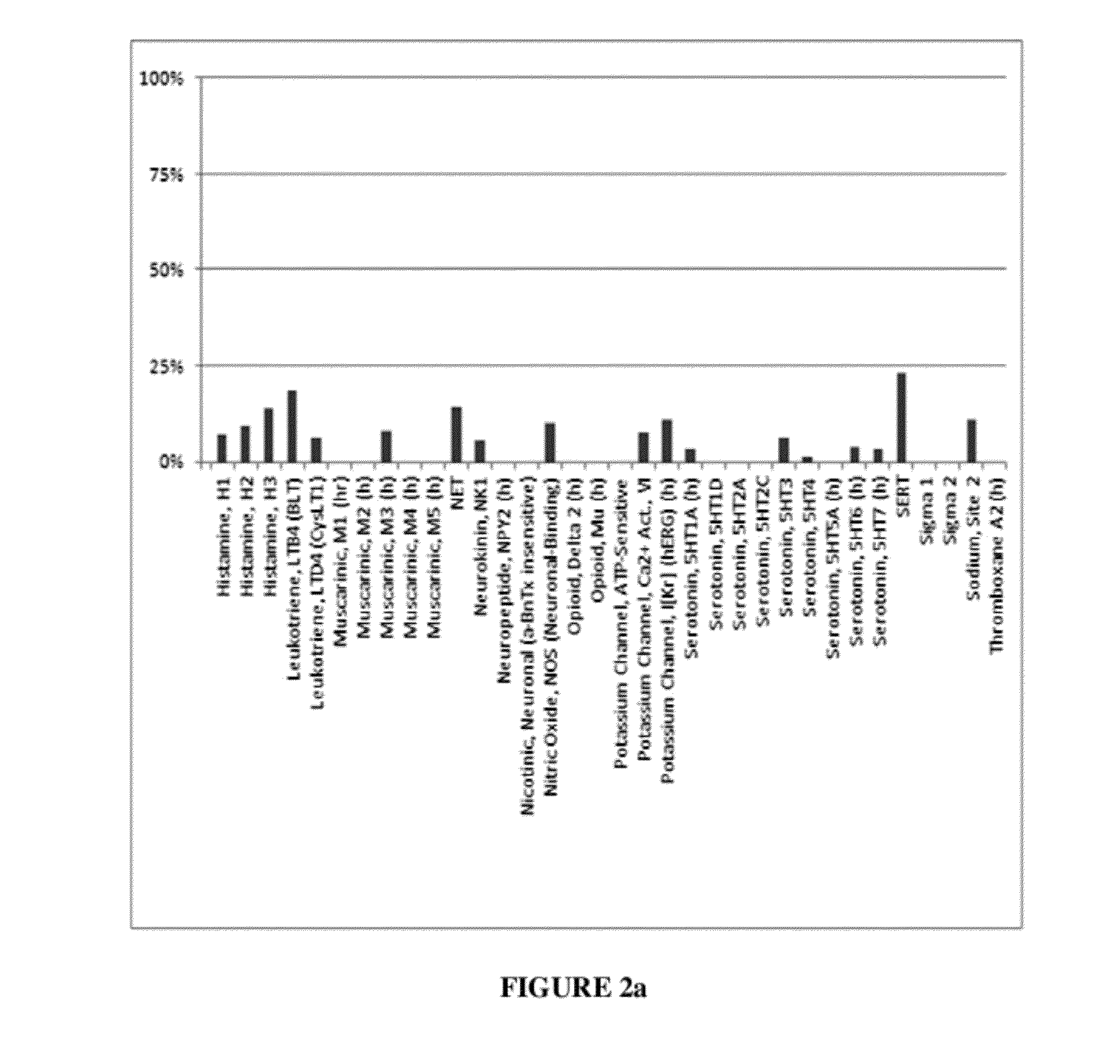Method of using dopamine reuptake inhibitors and their analogs for treating autoimmune conditions and delaying or preventing autoimmune related pathologic progressions
a technology of dopamine reuptake inhibitors and analogs, applied in the field of autoimmune diseases, can solve the problems of reducing the life expectancy reducing the sensitivity of lupus animal models, and reducing the severity of symptoms
- Summary
- Abstract
- Description
- Claims
- Application Information
AI Technical Summary
Benefits of technology
Problems solved by technology
Method used
Image
Examples
example 1
[0081]When evaluated in the radioligand binding assays, compounds were tested at 10 μM. At this specific concentration, compounds showed ≧90% inhibitory effect in the DAT binding assay (radioligand 3H-WIN5428) and 3H-Nisoxetine) are considered to be DAT specific. For instance, 3-(p-methylbenzyl)-sydnonimine-N-phenylcarbamoyl at 10 μM showed 94% inhibitory effect in the DAT binding assay; 14% in NET; 3-(p-methylbenzyl)-sydnonimine-N-phenylcarbamoyl was considered to be DAT specific. 3-(phenylpropyl)-sydnonimine-N-phenylcarbamoyl at the same concentration showed inhibitory effect with DAT about 96%; with NET, 1%. Likewise, 3-(phenylpropyl)-sydnonimine-N-phenylcarbamoyl was considered to be an DAT specific inhibitor. 3-(phenylethyl)-sydnonimine-N-phenylcarbamoyl, on the other hand, showed an inhibitory effect at DAT about 100% but with NET, 35% (at 10 μM), thus, 3-(phenylethyl)-sydnonimine-N-phenylcarbamoyl was considered to be a selective (instead of specific) DAT inhibitor.
example 2
[0082]Specific binding affinities in combination with functional radioligand uptake assays confirmed the selection threshold. 3-(p-methylbenzyl)-sydnonimine-N-phenylcarbamoyl showed a specific affinity with DAT KiDAT˜22 nM; 3-(phenylpropyl)-sydnonimine-N-phenylcarbamoyl, KiDAT˜7.5 nM; their radioligand binding affinity towards other catecholamine reuptake sites could not be precisely determined since the IC50s were >100 μM. The functional radioligand reuptake inhibition determinations using rat brain synaptosomal preparations gave selectivity profiles consistent with binding data, with both compounds showing no inhibition of reuptake of norepinephrine and serotonin, but potent inhibitory DA reuptake activity (EC50DAT: 3-(p-methylbenzyl)-sydnonimine-N-phenylcarbamoyl, 41 nM; 3-(phenylpropyl)-sydnonimine-N-phenylcarbamoyl, 100 nM). The corresponding data for 3-(phenylethyl)-sydnonimine-N-phenylcarbamoyl are binding, KiDAT=15 nM, KiNET>>10 μM; and functional, EC50DAT=100 nM, EC50NET=4....
example 3
[0083]Mediation of lupus conditions: Systemic lupus erythematosus (SLE) is a chronic, inflammatory, autoimmune disease of unknown origin. NZBWF1 / J (or NZB / W / J or NZB-NZW F1) develops an autoimmune disease resembling human systemic lupus erythematosus. Autoimmunity is characterized by high levels of antinuclear antibodies, hemolytic anemia, proteinuria, and progressive immune complex glomerulonephritis (GN). The incidence and severity of symptoms are more pronounced in females (Rudofsky and Lawrence, 1999). The penetrance for murine glomerulonephritis (GN) is about 85 (Morel and Wakeland, 1998) and the average lifespan for females NZBWF1 is 245 days. NZBWF1 / J mice have been used as a model for autoimmune disease since the early 1960s.
[0084]NZBWF1 / J mice were used in this study. 40 NZBWF1 / J mice (Jax labs; date of birth Oct. 13, 2009) were randomly divided into 4 groups (10 in each group). These animals were housed in groups (n=5) and kept under a 12-hr light / dark cycle with food and ...
PUM
| Property | Measurement | Unit |
|---|---|---|
| weight | aaaaa | aaaaa |
| weight | aaaaa | aaaaa |
| binding affinity | aaaaa | aaaaa |
Abstract
Description
Claims
Application Information
 Login to View More
Login to View More - R&D
- Intellectual Property
- Life Sciences
- Materials
- Tech Scout
- Unparalleled Data Quality
- Higher Quality Content
- 60% Fewer Hallucinations
Browse by: Latest US Patents, China's latest patents, Technical Efficacy Thesaurus, Application Domain, Technology Topic, Popular Technical Reports.
© 2025 PatSnap. All rights reserved.Legal|Privacy policy|Modern Slavery Act Transparency Statement|Sitemap|About US| Contact US: help@patsnap.com



